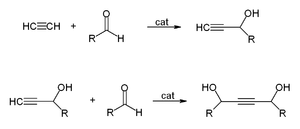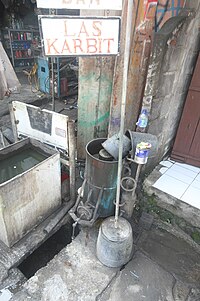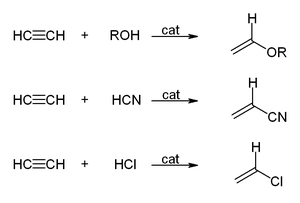Acetylene

| |

| |

| |
| Names | |
|---|---|
| IUPAC name
Ethyne
| |
| Systematic IUPAC name
Ethyne[1] | |
| Identifiers | |
3D model (JSmol)
|
|
| ChEBI | |
| ChEMBL | |
| ChemSpider | |
| ECHA InfoCard | 100.000.743 |
| KEGG | |
| UNII | |
| UN number | 1001 (dissolved) 3138 (in mixture with ethylene and propylene) |
CompTox Dashboard (EPA)
|
|
| |
| |
| Properties | |
| C2H2 | |
| Molar mass | 26.038 g·mol−1 |
| Density | 1.097 g/L = 1.097 kg/m3 |
| Melting point | −80.8 °C (−113.4 °F; 192.3 K) |
| Boiling point | −84 °C (−119 °F; 189 K) |
| slightly soluble | |
| Acidity (pKa) | 25[2] |
| Structure | |
| Linear | |
| Thermochemistry | |
Std molar
entropy (S⦵298) |
201 J·mol−1·K−1 |
Std enthalpy of
formation (ΔfH⦵298) |
+226.88 kJ/mol |
| Hazards | |
| NFPA 704 (fire diamond) | |
| 300 °C (572 °F; 573 K) | |
Except where otherwise noted, data are given for materials in their standard state (at 25 °C [77 °F], 100 kPa).
| |
Acetylene (systematic name: ethyne) is the chemical compound with the formula C2H2. It is a hydrocarbon and the simplest alkyne.[3] This colorless gas is widely used as a fuel and a chemical building block. It is unstable in pure form and thus is usually handled as a solution.[4] Pure acetylene is odorless, but commercial grades usually have a marked odor due to impurities.[5]
As an alkyne, acetylene is unsaturated because its two carbon atoms are bonded together in a triple bond. The carbon–carbon triple bond places all four atoms in the same straight line, with CCH bond angles of 180°. Since acetylene is a linear symmetrical molecule, it possesses the D∞h point group.[6]
Discovery
Acetylene was discovered in 1836 by Edmund Davy, who identified it as a "new carburet of hydrogen".[7] It was rediscovered in 1860 by French chemist Marcellin Berthelot, who coined the name "acetylene". Berthelot was able to prepare this gas by passing vapours of organic compounds (methanol, ethanol, etc.) through a red-hot tube and collecting the effluent. He also found acetylene was formed by sparking electricity through mixed cyanogen and hydrogen gases. Berthelot later obtained acetylene directly by passing hydrogen between the poles of a carbon arc.[8] Commercially available acetylene gas could smell foul due to the common impurities hydrogen sulphide and phosphine. However, acetylene gas with high purity would generate a light and sweet smell.
Preparation
Today acetylene is mainly manufactured by the partial combustion of methane or appears as a side product in the ethylene stream from cracking of hydrocarbons. Approximately 400,000 tonnes are produced by this method annually.[4] Its presence in ethylene is usually undesirable because of its explosive character and its ability to poison Ziegler-Natta catalysts. It is selectively hydrogenated into ethylene, usually using Pd–Ag catalysts.[9]
Until the 1950s, when oil supplanted coal as the chief source of reduced carbon, acetylene (and the aromatic fraction from coal tar) was the main source of organic chemicals in the chemical industry. It was prepared by the hydrolysis of calcium carbide, a reaction discovered by Friedrich Wöhler in 1862 and still familiar to students:
- CaC2 + 2H2O → Ca(OH)2 + C2H2
Calcium carbide production requires extremely high temperatures, ~2000 °C, necessitating the use of an electric arc furnace. In the US, this process was an important part of the late-19th century revolution in chemistry enabled by the massive hydroelectric power project at Niagara Falls.[10]
Bonding
In terms of valence bond theory, in each carbon atom the 2s orbital hybridizes with one 2p orbital thus forming an sp hybrid. The other two 2p orbitals remain unhybridized. The two ends of the two sp hybrid orbital overlap to form a strong σ valence bond between the carbons, while on each of the other two ends hydrogen atoms attach also by σ bonds. The two unchanged 2p orbitals form a pair of weaker π valence bonds.[11]
Physical properties
Changes of state
At atmospheric pressure, acetylene cannot exist as a liquid and does not have a melting point. The triple point on the phase diagram corresponds to the melting point (−80.8 °C) at the minimum pressure at which liquid acetylene can exist (1.27 atm). At temperatures below the triple point, solid acetylene can change directly to the vapor (gas) by sublimation. The sublimation point at atmospheric pressure is −84 °C.
Other
The adiabatic flame temperature in air at atmospheric pressure is 2534 °C.
Acetylene gas can be dissolved in acetone or dimethylformamide in room temperature and 1 atm.
Reactions
One new application is the conversion of acetylene to ethylene for use in making a variety of polyethylene plastics. An important reaction of acetylene is its combustion, the basis of the acetylene welding technologies. Otherwise, its major applications involve its conversion to acrylic acid derivatives.[4]
Compared to most hydrocarbons, acetylene is relatively acidic, though it is still much less acidic than water or ethanol. Thus it reacts with strong bases to form acetylide salts. For example, acetylene reacts with sodium amide in liquid ammonia to form sodium acetylide, and with butyllithium in cold THF to give lithium acetylide.[12]
Acetylides of heavy metals are easily formed by reaction of acetylene with the metal ions. Several, e.g., silver acetylide (Ag2C2) and copper acetylide (Cu2C2), are powerful and very dangerous explosives.[13]
Reppe chemistry
Walter Reppe discovered that in the presence of metal catalysts, acetylene can react to give a wide range of industrially significant chemicals.[14][15]
- With alcohols, hydrogen cyanide, hydrogen chloride, or carboxylic acids to give vinyl compounds:[4]
- With aldehydes to give ethynyl diols,[4] in the Favorskii reaction:

- 1,4-Butynediol is produced industrially in this way from formaldehyde and acetylene.
- With carbon monoxide to give acrylic acid, or acrylic esters, which can be used to produce acrylic glass:[16]
- Cyclicization to give benzene, cyclooctatetraene,[4] or hydroquinone:[15]


- File:Corrected version of Walter Reppe Hydroquinone synthesis via iron pentacarbonyl under basic conditions.svg
Welding

Niche applications
In 1881, the Russian chemist Mikhail Kucherov[19] described the hydration of acetylene to acetaldehyde using catalysts such as mercury(II) bromide. Before the advent of the Wacker process, this reaction was conducted on an industrial scale.[20]
The polymerization of acetylene with Ziegler-Natta catalysts produces polyacetylene films. Polyacetylene, a chain of CH centres with alternating single and double bonds, was the one of first discovered organic semiconductors. Its reaction with iodine produces a highly electrically conducting material. Although such materials are not useful, these discoveries led to the developments of organic semiconductors, as recognized by the Nobel Prize in Chemistry in 2000 to Alan J. Heeger, Alan G MacDiarmid, and Hideki Shirakawa.[4]
In the early 20th Century acetylene was widely used for illumination, including street lighting in some towns.[21] Most early automobiles used carbide lamps before the adoption of electric headlights.
Acetylene is sometimes used for carburization (that is, hardening) of steel when the object is too large to fit into a furnace.[22]
Acetylene is used to volatilize carbon in radiocarbon dating. The carbonaceous material in an archeological sample is treated with lithium metal in a small specialized research furnace to form lithium carbide (also known as lithium acetylide). The carbide can then be reacted with water, as usual, to form acetylene gas to be fed into mass spectrometer to sort out the isotopic ratio of carbon-14 to carbon-12.[23]
Natural occurrence
Acetylene is a moderately common chemical in the universe, often associated with the atmospheres of gas giants.[24] One curious discovery of acetylene is on Enceladus, a moon of Saturn. Natural acetylene is believed to form from either catalytic decomposition of long chain hydrocarbons at temperatures of 1,770 K and above. Since such temperatures are highly unlikely on such a small distant body, this discovery is potentially suggestive of catalytic reactions within that moon, making it a promising site to search for prebiotic chemistry.[25][26]
Safety and handling
Acetylene is not especially toxic but when generated from calcium carbide it can contain toxic impurities such as traces of phosphine and arsine. It is also highly flammable (hence its use in welding). Its singular hazard is associated with its intrinsic instability, especially when it is pressurized. Samples of concentrated or pure acetylene can easily react in an addition-type reaction to form a number of products, typically benzene and/or vinylacetylene. These reactions are exothermic, and unlike other common flammables, do not require oxygen to proceed. Consequently, acetylene can explode with extreme violence if the absolute pressure of the gas exceeds about 200 kPa (29 psi). Most regulators and pressure gauges on equipment report gauge pressure and the safe limit for acetylene therefore is 101 kPagage or 15 psig.[27][28] It is therefore shipped and stored dissolved in acetone or dimethylformamide (DMF),[29] contained in a gas cylinder with a porous filling (Agamassan), which renders it safe to transport and use, given proper handling. Copper catalyses the decomposition of acetylene and as a result acetylene should not be transported in copper pipes. Brass pipe fittings should also be avoided.
Portable lighting
Calcium carbide was used to generate acetylene used in the lamps for portable or remote applications. It was used for miners and cavers before the widespread use of incandescent lighting; or many years later low-power/high-lumen LED lighting; and is still used by mining industries in some nations without workplace safety laws. It was also used as an early light source for lighthouses.
References
- ^ Acyclic Hydrocarbons. Rule A-3. Unsaturated Compounds and Univalent Radicals, IUPAC Nomenclature of Organic Chemistry
- ^ [1], Gas Encyclopaedia, Air Liquide
- ^ R.H.Petrucci, W.S.Harwood and F.G.Herring "General Chemistry", 8th edn.(Prentice-Hall 2002), p.1072
- ^ a b c d e f g Pässler, Peter; Hefner, Werner; Buckl, Klaus; Meinass, Helmut; Meiswinkel, Andreas; Wernicke, Hans-Jürgen; Ebersberg, Günter; Müller, Richard; Bässler, Jürgen; Behringer, Hartmut; Mayer, Dieter (2008). "Ullmann's Encyclopedia of Industrial Chemistry". doi:10.1002/14356007.a01_097.pub3. ISBN 3527306730.
{{cite journal}}:|chapter=ignored (help); Cite journal requires|journal=(help). Article Online Posting Date: 15 October 2008 - ^ Compressed Gas Association (1995) Material Safety and Data Sheet – Acetylene.
- ^ Housecroft, C. E.; Sharpe, A. G. (2008). Inorganic Chemistry (3rd ed.). Prentice Hall. pp. 94–95. ISBN 978-0-13-175553-6.
- ^ Miller, S.A. (1965). Acetylene: Its Properties, Manufacture and Uses. Vol. 1. Academic Press Inc.
- ^ Acetylene
- ^ Acetylene: How Products are Made
- ^ Freeman, Horace (1919). "Manufacture of Cyanamide". The Chemical News and the Journal of Physical Science. 117: 232. Retrieved 23 December 2013.
- ^ Organic Chemistry 7th ed. by J. McMurry, Thomson 2008
- ^ Midland, M. M.; McLoughlin, J. I.; Werley, Ralph T. (Jr.) (1990). "Preparation and Use of Lithium Acetylide: 1-Methyl-2-ethynyl-endo-3,3-dimethyl-2-norbornanol". Organic Syntheses. 68: 14
{{cite journal}}: CS1 maint: multiple names: authors list (link); Collected Volumes, vol. 8, p. 391. - ^ Greenwood, Norman N.; Earnshaw, Alan (1997). Chemistry of the Elements (2nd ed.). Butterworth-Heinemann. ISBN 978-0-08-037941-8.
- ^ Peter Pässler, Werner Hefner, Klaus Buckl, Helmut Meinass, Andreas Meiswinkel, Hans-Jürgen Wernicke, Günter Ebersberg, Richard Müller, Jürgen Bässler, Hartmut Behringer and Dieter Mayer (2007). "Acetylene". Ullmann's Encyclopedia of Industrial Chemistry: pg. 44. doi:10.1002/14356007.a01_097.pub2. Retrieved 26 December 2013.
{{cite journal}}:|page=has extra text (help)CS1 maint: multiple names: authors list (link) - ^ a b Reppe, Walter; Kutepow, N; and Magin, A (1969). "Cyclization of Acetylenic Compounds". Angewandte Chemie International Edition in English. 8 (10): 727–733. doi:10.1002/anie.196907271. Retrieved 26 December 2013.
{{cite journal}}: CS1 maint: multiple names: authors list (link) - ^ Takashi Ohara, Takahisa Sato, Noboru Shimizu, Günter Prescher, Helmut Schwind, Otto Weiberg, Klaus Marten and Helmut Greim (2003). "Acrylic Acid and Derivatives". Ullmann's Encyclopedia of Industrial Chemistry: pg. 7. doi:10.1002/14356007.a01_161.pub2. Retrieved 26 December 2013.
{{cite journal}}:|page=has extra text (help)CS1 maint: multiple names: authors list (link) - ^ "Acetylene". Products and Supply > Fuel Gases. Linde. Retrieved 30 November 2013.
- ^ Acetylene - Properties, Purity and Packaging - Acetylene is simplest member of unsaturated hydrocarbons called alkynes or acetylenes. Most important of all starting materials ...
- ^ Kutscheroff, M. (1881). "Ueber eine neue Methode direkter Addition von Wasser (Hydratation) an die Kohlenwasserstoffe der Acetylenreihe". Berichte der deutschen chemischen Gesellschaft. 14: 1540–1542. doi:10.1002/cber.188101401320.
- ^ Dmitry A. Ponomarev and Sergey M. Shevchenko (2007). "Hydration of Acetylene: A 125th Anniversary" (PDF). J. Chem. Ed. 84 (10): 1725. doi:10.1021/ed084p1725.
- ^ The 100 most important chemical compounds: a reference guide
- ^ "Acetylene". Products and Services. BOC. Archived from the original on 17 May 2006.
- ^ Geyh, Mebus (1990). "Radiocarbon dating problems using acetylene as counting gas". Radiocarbon. 32 (3): 321–324. doi:10.2458/azu_js_rc.32.1278. Retrieved 26 December 2013.
- ^ "Precursor to Proteins and DNA found in Stellar Disk" (Press release). W. M. Keck Observatory. 20 December 2005.
- ^ Emily Lakdawalla (17 March 2006). "LPSC: Wednesday afternoon: Cassini at Enceladus". The Planetary Society.[dead link]
- ^ John Spencer and David Grinspoon (25 January 2007). "Planetary science: Inside Enceladus". Nature. 445 (7126): 376–377. doi:10.1038/445376b. PMID 17251967.
- ^ Korzun, Mikołaj (1986). 1000 słów o materiałach wybuchowych i wybuchu. Warszawa: Wydawnictwo Ministerstwa Obrony Narodowej. ISBN 83-11-07044-X. OCLC 69535236.
- ^ "Acetylene Specification". CFC StarTec LLC. Retrieved 2 May 2012.
- ^ Downie, N. A. (1997). Industrial Gases. London; New York: Blackie Academic & Professional. ISBN 978-0-7514-0352-7.
{{cite book}}:|access-date=requires|url=(help)
External links
- Acetylene at Chemistry Comes Alive!
- Acetylene, the Principles of Its Generation and Use at Project Gutenberg
- Movie explaining acetylene formation from calcium carbide and the explosive limits forming fire hazards
- Calcium Carbide & Acetylene at The Periodic Table of Videos (University of Nottingham)
- CDC - NIOSH Pocket Guide to Chemical Hazards - Acetylene









